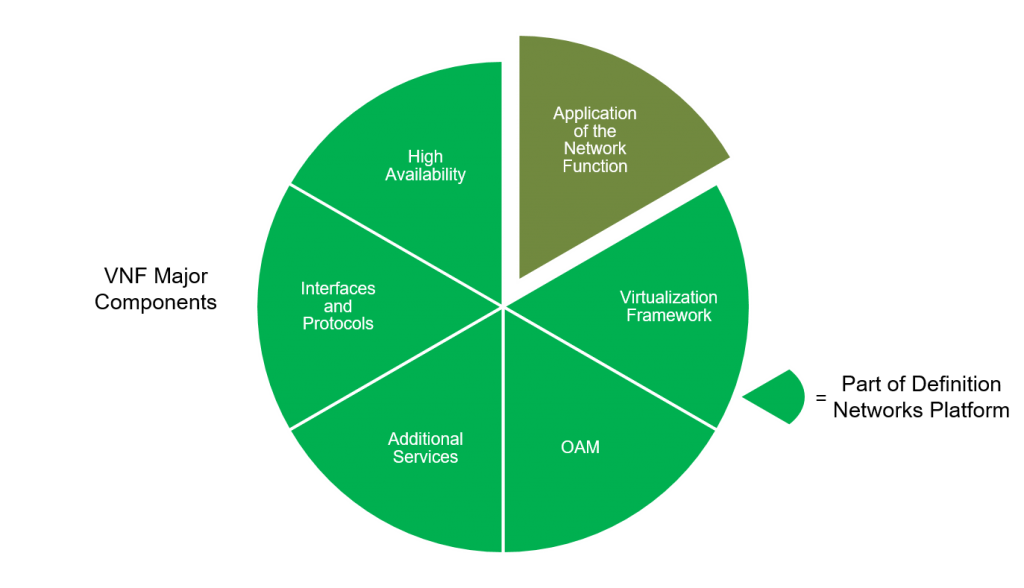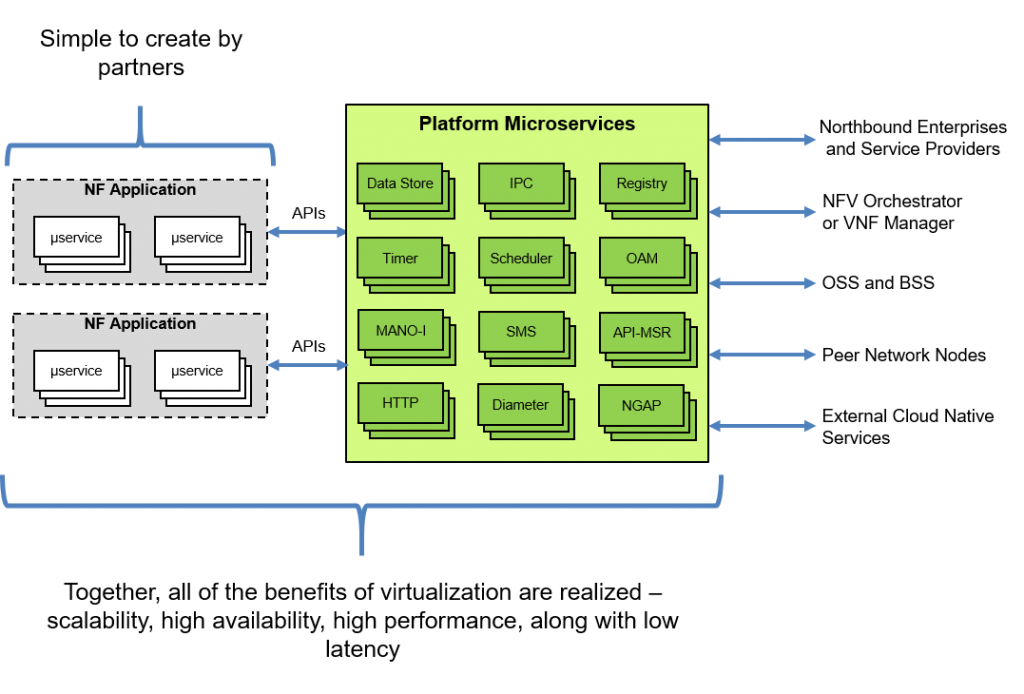DN 5G Platform
Definition Networks (DN) offers its Cloud Native Microservices Platform as the industry’s first such platform engineered specifically for development of 5G Network Functions and Network Applications.
The DN 5G Platform provides much of the functionality that any network element requires, and it provides the functionality in a way that is ideal for Container or VM (Virtual Machine) virtualization in both public cloud and private cloud deployments.
The 5G packet core will run on a virtualized infrastructure, with each 5G Network Function being a VNF (Virtual Network Function). Typically, the DN 5G Platform will account for approximately 70% of the VNF software.
Typically, the DN 5G Platform will account for approximately 70% of the VNF software.
With the DN 5G Platform, 5G carrier-class network elements become simple to build.
- Time to market. Design and coding effort timeline is measured in weeks/months, not months/years.
- Extreme scalability, redundancy, high performance and low latency. Carrier-class qualities, realizing all the benefits of virtualization.
- Robustness. The requirements for the vendor’s application code become simplified in the network element, resulting in the application being more robust and easier to enhance for future customer requests.
The DN 5G Platform can also be used to build 4G Network Functions and Network Applications, since the DN 5G Platform includes Diameter microservices needed to interface with 4G (and earlier) network elements.
A service-based architecture is required in the 3GPP 5G architecture specifications. For virtualization to be effective and efficient, each service instance must be small, i.e., a microservice. Having the microservices be independent is also critical. That results in not only scalability and redundancy, but also resource efficiency (which translates directly into better performance, i.e., “bang for the buck”). The Kubernetes orchestration or VM MANO (Management and Orchestration) is able to efficiently pack the microservices onto servers with desired anti-affinity rules, resulting in server resource efficiency.
DN has taken the complex parts of network elements, and implemented those parts as small, independent microservices. The DN 5G Platform also provides the necessary load-balancing mesh interconnectivity between microservices. As a result, creating a network element is simple – it can be realized by run-to-completion tasks, with the complex parts being done by the microservices of the DN 5G Platform.
Below, we illustrate how a Network Function (NF) Application can consist of simple microservices (µservices), interfacing with the DN 5G Platform’s microservices. Separating the resiliency complications and complex interfaces from the applications that run on the platform is key to a robust product. This enables applications to be easily created and less prone to errors. Going from left to right, we first see the microservices of the Network Function Application. Those are simple to create, as complications by addressing redundancy don’t exist. These scalable microservices can be stateless run-to-completion, using our Data Store microservice to save or retrieve any necessary context information.
Going from left to right, we first see the microservices of the Network Function Application. Those are simple to create, as complications by addressing redundancy don’t exist. These scalable microservices can be stateless run-to-completion, using our Data Store microservice to save or retrieve any necessary context information.
The Network Function Applications use straight-forward APIs with the DN 5G Platform’s microservices. Our microservices constitute the bulk of the software needed by the VNF. Our microservices include the following.
- Data Store. All data related to transaction processing, configuration, statistics, alarms and microservice states can be saved in the DN Data Store microservice. Our Data Store was designed specifically for virtualization. Besides its many redundancy options (n+k, and geographic redundancy), it has vastly superior benchmark performance compared to a competing database.
- IPC. We provide the Inter Processing Communication. This uses service-based APIs providing reliable low-latency communication among the mesh of microservices. [Ingress controllers (for Kubernetes) and load balancers that are part of the virtualization system only perform load balancing on incoming transactions – mesh connections and load balancing as different microservices communicate with each other is done by our IPC.]
- Registry. We provide the microservice registry, so applications can easily discover and register with the desired DN 5G Platform microservices.
- Timer. Our Timer management allows the applications to create all necessary timers. Our Timer management interfaces with our Data Store, so applications need not be concerned with redundancy for the timers.
- Scheduler. Our intelligent Scheduler uses destination-specific policies to avoid congestion.
- OAM. Our OAM microservices perform many functions.
- Configuration
- Alarms
- Counters and KPIs aggregation
- CDRs
- Logging
- Trace
- Lawful Intercept
- MANO-I. For VM deployments, our MANO interworking microservice provides the SVNFM (Specialized VNF Manager) or provides the necessary interworking with the GVNFM (Generic VNF Manager) of the Operator, including VM Onboarding, VM Monitoring, SW Management and Scaling, For Container deployments, the kubelet within each Kubernetes node interfaces with the orchestration done by K8s.
- SMS*. Our SMS delivery microservice enables the network applications to send SMS to devices, bypassing the SMS-SC. This has great applicability for the forecasted IoT explosive growth, which heavily leverages SMS while existing SMS-SCs are not easily scaled up.
- API-MSR*. Our API-MSR (API Management, Services and Routing) enables the DN Platform to be the access point to the Operator’s network for all Enterprises’ API accesses. It provides centralized API policy management, including API security and API rate-control, so the Operator can offer and enforce API SLAs with Enterprises.
- HTTP. Our scalable HTTP processing performs load balancing and demultiplexing to the VNF’s microservices.
- Diameter. Our scalable Diameter processing does demultiplexing to the VNF’s microservices. The Operator may deploy a Diameter Signaling Router for load balancing to multiple instances of our Diameter microservice.
- NGAP*. Our scalable NGAP (Next Generation Application Protocol) is for use by the 5G AMF and gNB Network Functions.
* = These microservices are intended for particular network functions or network applications.
Our microservices contain the complex interfaces with the external components.
- Northbound Enterprises and Service Providers. These interfaces use APIs, with our API-MSR enforcing SLAs with the consumers.
- MANO. Our MANO-I microservice interfaces with the external MANO’s NFVO or VNFM.
- OSS and BSS. We support popular protocols, like NETCONF and SNMP. We also provide RBAC (Role Based Access Control) REST APIs.
- Peer Network Nodes. The DN Platform interfaces with both 5G and 4G (and earlier) peer network nodes.
- External Cloud Native Services. These are easily integrated with the DN Platform, for services like Prometheus (monitoring), Grafana (analytics) and Loki (logging).
This table summarizes many of the benefits of the DN 5G Platform.
Aspect | DN Cloud Native Microservices Platform |
Cloud Native Virtualization | Cloud native microservice architecture |
Carrier-class | Extreme scalability |
Simplifies partner efforts | Simple, stateless run-to-completion tasks by partner |
For those interested in partnering to use our DN Cloud Native Microservices 5G Platform for their own developments of network functions and network applications, please Contact Us to request further information.
